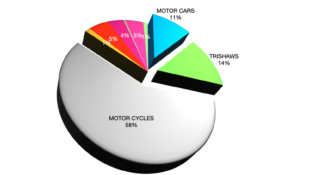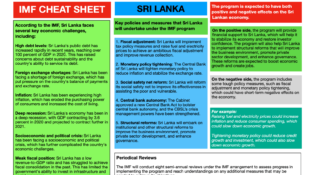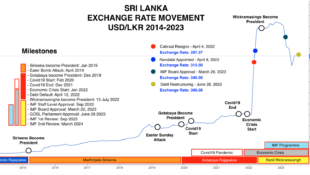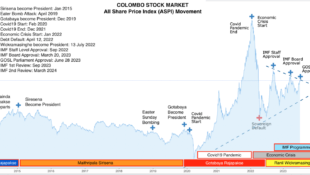"We expect business growth to slow in CY12/CY13 as the government curbs demand to tackle the current account imbalance. However, we are long-term positive given healthy GDP growth expectations of 7–7.5% and low financial sector penetration. Valuations too have fallen sharply with top private banks at 1.2–1.6x CY13E BV," Religare said.
Excerpts of the report follows:
GDP growth strong but likely to moderate: The Sri Lankan economy reported strong growth of ~8.0%/8.3% in CY10/CY11 driven by higher business confidence arising from a return to peace after decades of civil war, along with the government’s continued thrust on infrastructure development. However, the current account deficit has widened from 2.2% in CY10 to 7.8% in CY11 due to the sharp increase in oil prices and strong consumer demand. Inflation was low at 4.9% in December’11 but has increased in H1CY12 due to the spike in energy prices. As a result, the Central Bank of Sri Lanka (CBSL) has tightened liquidity and policy rates. We expect GDP growth to moderate but still remain at healthy levels of 7–7.5% in CY12/CY13.
Loan growth to slow: Sri Lanka’s financial services industry is largely dominated by the banking sector, with total assets of banks (both licenced commercial and specialised banks) constituting ~64% of the assets of financial institutions in September’11. Loan growth has remained strong at 24%/31% YoY in CY10/CY11. However, to reduce consumer demand, CBSL has imposed a credit ceiling of 23% (18% growth from domestic funds and balance from overseas funds). Consequently, we expect loan growth to slow to 20–22% for banks in CY12/CY13.
NIMs to stabilise at current levels: NIMs have remained under pressure in CY11 due to a sharp fall in lending rates and abundant liquidity. The CASA proportion too has declined due to strong growth in bank balance sheets. We expect CASA to decline further from current levels. However, lending rates have started going up as CBSL has tightened liquidity and increased policy rates/statutory reserve ratio (SLR). With an improvement in lending rates, we expect NIMs to stabilise in CY12.
= Asset quality has improved significantly; operating leverage to play out: Asset quality deteriorated sharply in CY08 and CY09 with GNPA for the sector increasing from ~5.2% in December’07 to ~8.5% in CY09 due to the financial crisis and escalation of war efforts. However, with robust GDP and profit growth and a revival in global demand, bank GNPLs/NNPLs have improved significantly to 3.8% in December’11. We expect GNPLs/NNPLs to remain largely stable in CY12.
=Valuations attractive post sharp correction: Sri Lankan banks have reported strong earnings growth (earnings of top 5 banks grew at a 54% CAGR over CY09-CY11). We expect earnings growth to remain healthy driven by healthy business growth and stable NIMs and asset quality. Stocks have corrected significantly in the last 12 months with the stock index declining by 27%. Post-correction, leading private sector banks are now trading at 1.2–1.6x CY12E BV and 8.0–9.0x EPS, which is attractive from a long-term view.
Investment rationale
We remain positive on Sri Lankan banks despite the challenging macro environment, due to the low financial sector penetration in the country. GDP growth is likely to moderate from 8.3% in CY11 but should remain healthy at 7–7.5% in CY12/CY13. Earnings growth is also expected to remain healthy and valuations are attractive post-correction in the last 12 months. Leading private sector banks are now trading at 1.2–1.6x CY12E BV and 8.0–9.0x CY12E EPS.
= Credit growth has remained strong at 30%+ in CY11 due to robust corporate and consumer demand. However, demand is likely to moderate going forward given a tightening monetary policy (which has led to higher lending rates) and a slowdown in economic growth.
= Asset quality has improved significantly in CY10 and CY11 with banks witnessing lower slippages and strong recoveries. We expect GNPLs to stabilise at current levels.
= Liability profiles of Sri Lankan banks are robust with a high proportion of low-cost CASA deposits (45–50% for larger banks except National Savings Bank, NSB). However, the CASA proportion declined marginally in CY11 due to strong balance sheet growth. We are factoring in marginal declines in CY12/CY13 as well.
= NIMs dipped in CY11 due to a fall in lending rates and the declining proportion of CASA deposits. Now, with the tighter policy and rising rates, we expect margins to stabilise at current levels.
= Capital adequacy in the banking system is comfortable with a CAR/tier I ratio of 15%+/13%+. Leverage and common equity ratios are also much higher than that required under Basel III guidelines.
Strong GDP growth in CY10/CY11
Sri Lanka’s economic growth accelerated from 3.5% in CY09 to 8.0%/~8.3% in CY10/CY11 driven by a revival in global demand, increased business confidence after the war and the government’s continued thrust on infrastructure development, particularly in the country’s northern region. Industries grew by 10.3% in CY11 – the highest growth rate in the last three decades. The services sector grew by 8.6% YoY in CY11 supported by improved trade activities and tourism. At the end of CY11, industry and services constituted ~29.3% and 59.5% of total GDP respectively. Agriculture growth was subdued at 1.5% due to bad weather conditions and constituted ~11.2% of total GDP.
Easy monetary policy supported GDP growth
The strong GDP growth was also supported by an easy monetary policy which ensured abundant liquidity and lower lending rates. The CBSL reduced the repo rate from 10.25% in February’09 to 7.0% in January’11 and the statutory reserve ratio from 9.25% in October’08 to 7.0% in February’09. Average prime lending rates of banks declined sharply from 18.5% in CY08 to ~10.8% in CY11 due to the abundant liquidity.
Inflation has remained benign in CY10/CY11…
Inflation remained benign in CY11 driven by improved domestic supply conditions. Average inflation for the year was ~6.7% in CY11; however, in December’11 it moderated to 4.9% YoY.
…but sharp LKR depreciation likely to be inflationary
We expect inflation to move up in CY12 due to the increase in energy prices and sharp LKR depreciation. Sri Lanka’s current account deficit (CAD) has deteriorated significantly from 2.2% of GDP in CY10 to 7.8% in CY11 (from US$ 1.1bn to US$ 4.6bn) due to a sharp increase in imports. Total imports increased by 50.7% YoY on account of the spike in oil prices and higher demand for consumer and investment goods. Exports, on the other hand, grew by only 22% YoY. This coupled with global risk aversion has resulted in sharp LKR depreciation against the dollar over the last six months.
Expects GDP and credit growth to moderate in CY12/CY13
CBSL has tightened liquidity and increased policy rates to address the impact of higher credit growth on the trade deficit and the macro-economy. The central bank increased the repurchase rate and reverse repurchase rate by 75bps and 125bps respectively in last six months. Excess liquidity in the money market has also declined due to CBSL action and sharp credit growth. As a result, short-term rates and average lending rates have increased in the last six months.
We expect GDP growth of 7-7.5% in CY12/CY13 from ~8.0%+ in CY10/CY11. Credit growth is likely to moderate from 24%/31% in CY10/CY11 to 20–22% in CY12/CY13. CBSL has restricted credit growth for banks to a maximum of 23% (18% growth from domestic funds and balance from overseas funds).
Well diversified asset books
The asset books of Sri Lankan banks are well diversified. As per CBSL regulations, licenced commercial banks (LCB) are required to maintain ~20% of their net time and demand liabilities in the form of government securities. As on 31 December 2011, the total investment in government securities far exceeded the regulatory requirement. Loans and advances constitute ~59% of total assets and are well diversified in nature.
Liability profile – CASA proportion likely to decline further
Liability profiles of Sri Lankan banks are healthy with low-cost current and saving deposits constituting ~45% of total deposits for large banks. However, the CASA proportion for leading banks has declined in CY11 as deposit mobilisation growth has not kept pace with overall balance sheet growth. We expect CASA to decline further in CY12/CY13 as higher rates and tight liquidity could put pressure on savings and current account deposit mobilisation.
NIMs declined in CY11...
Overall NIMs in Sri Lanka are robust at 4.0–4.5% due to high yields on advances and a strong liability franchise, marked by a CASA ratio of ~45%. NIMs for the banking system remained largely stable in CY10 as a sharp decline in yield on assets was offset by a lower cost of deposits (led by higher low-cost deposit mobilisation and a decline in term deposit rates), coupled with an improvement in C/D ratio. However, NIMs came under pressure in CY11 due to abundant liquidity (which led to pressure on yields) and a declining proportion of CASA deposits.
...but likely to stabilise at current levels going forward
While we expect the CASA proportion to decline even from current levels in the near term, we believe NIMs are likely to stabilise as lending rates move up, offsetting the higher borrowing costs. We note that the bargaining power of banks has increased significantly with the tightening of liquidity and increase in policy rates by CBSL. As a result, lending rates have started going up which would benefit banks as assets are re-priced faster than liabilities.
Asset quality has improved significantly; likely to remain stable
Overall asset quality declined in CY08 and CY09 as slippages increased due to the global financial crisis, escalation of war efforts and higher lending rates. However, with robust economic growth, a revival in external demand and surrender of the LTTE, incremental slippages have come down significantly. Moreover, all large banks are witnessing strong recoveries from earlier NPAs, boosting their non-interest income and profitability. As per CBSL, gross NPA in the system has come down from ~8.5% in CY09 to ~5.4% in CY10 and 3.8% in CY11. While we expect GDP growth to moderate in CY12/CY13, we believe GNPL ratios would remain largely stable as corporate profitability holds firm and households remain under-leveraged.
Cost-to-income ratio to decline due to operating leverage
The C/I ratio for Sri Lankan banks has increased marginally in CY11 due to their continued investments in employees and distribution network. Introduction of the deposits insurance scheme by CBSL in Q3CY10 also led to higher operating expenses. However, going forward, we expect marginal improvement in the C/I ratio driven by higher operating leverage.
Capital position healthy
Sri Lankan banks are adequately capitalised. At the end of December’10, the total CAR/tier I ratio stood at 16%/14%. While the banks have recorded strong asset growth in CY11, we note that most of them have also raised capital (both equity and subordinated debt). As per CBSL, the CAR/tier I ratio of Sri Lankan banks is likely to remain at 15%+/13%+ in CY11. Moreover, ~71% of tier I capital consisted of share capital and retained earnings. Capital funds-to-asset (leverage ratio) and common equity ratios are at ~9% and 8% respectively (much above the levels required under Basel III).
Reduction in effective tax rates boosted ROEs
Sri Lankan banks were heavily taxed in CY10 as they had to pay value-added tax (financial VAT) of 20% apart from corporate tax of 35%. However, the government has reduced the corporate tax rate from 35% to 28% (from 1 April 2011) and financial VAT from 20% to 12% (from 1 January 2011). As a result, effective tax rates of Sri Lankan banks have declined in CY11, boosting their profitability ratios. ROA/ROEs of the two largest private sector banks have increased from 1.6%/18% for Commercial Bank of Ceylon and 1.6%/17.3% for Hatton National Bank in CY10 to 2.0%/20.7% and 1.8%/17.7% respectively in CY11.
Valuations: Attractive post sharp correction
Following the sharp run-up in CY09 and CY10 (broader index rallied by 114% and 96% respectively) in anticipation of strong GDP growth in the post-war period, the equity market consolidated in CY11 due to restrictions on credit extended by brokers and exposure limits on bank lending, along with continued net foreign capital outflows. The broader index declined by 9% in CY11 and 17% YTD.
Banking stocks have also corrected significantly in last one year and are now trading at attractive valuations, in our view. Sri Lankan banks have reported strong earnings growth in the last two years with the top 5 banks delivering a 54% earnings CAGR over CY09-CY11. We expect earnings growth to remain healthy given GDP growth of 7–7.5% and strong asset quality. From our coverage universe, we expect COMB/HNB to post an earnings growth of 19%/17% over CY11-CY13. COMB is currently trading at 1.6x CY12E BV (1.8x after adjusting revaluation reserve from networth)/8.8x CY12E EPS and HNB at 1.3x CY12E BV (1.5x after adjusting revaluation reserve) /8.3x CY12E EPS.
http://www.island.lk/index.php?page_cat=article-details&page=article-details&code_title=55443
 would enable you to enjoy an array of other services such as Member Rankings, User Groups, Own Posts & Profile, Exclusive Research, Live Chat Box etc..
would enable you to enjoy an array of other services such as Member Rankings, User Groups, Own Posts & Profile, Exclusive Research, Live Chat Box etc.. 
 Home
Home
















